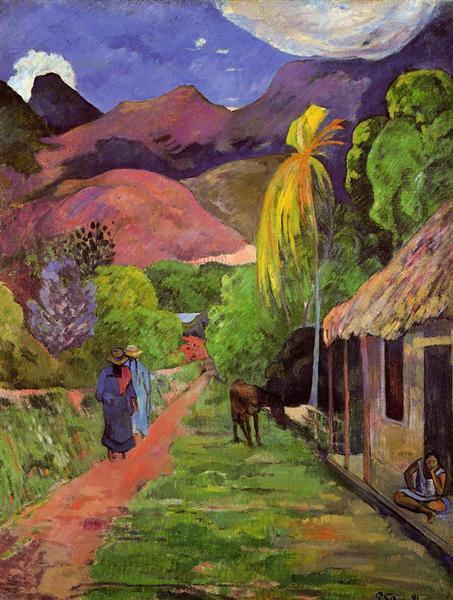Description
Paul Gauguin's painting "Road in Tahiti" (1891) is an emblematic work that encapsulates the artist's search for an expressive style and a representation of reality that distances itself from the impressionism that had dominated his early works. Composed during his first trip to Tahiti, the painting reflects his fascination with the tropical landscape, the local culture, and a way of life that he considered more authentic and free compared to the sophistication of the Europe of his time. Venturing into this work means entering the vibrant world of a Gauguin who rebelled against artistic conventions and sought new forms of expression.
The composition of “Road in Tahiti” is articulated through an almost diagonal arrangement of the landscape that guides the viewer’s eye towards the background of the canvas. A path, austere but evocative, meanders through a lush setting, while the presence of palm trees and tropical vegetation enriches the space with an almost tactile texture. The choice of angle and perspective allows the horizon to merge with a sky that, although predominantly blue, is tinged with shades of yellow and orange, perhaps suggesting an approaching sunset, or the warmth of the Tahitian climate. This use of color, characteristic of the symbolism that Gauguin embraced, provides a dreamlike atmosphere that invites contemplation.
Gauguin uses a vivid yet harmonious color palette, combining intense greens with deep blues and accents of light that bring emotional depth to the work. The way his hues are applied, often in thick, bold brushstrokes, creates a sense of movement that contrasts with the inherent tranquility of the landscape. This technique helps to demonstrate his interest in transcending mere visual reproduction; he is more interested in what those colors and shapes are able to convey in terms of emotion and symbolism.
Certainly, the cultural context in which "Road in Tahiti" is produced is key to understanding it in its full dimension. Upon arriving on the island, Gauguin not only found a physical space, but a population that maintained traditions and a way of life that he considered less corrupt. Even though the road in the painting seems like a physical passage, it can also be interpreted as a path to a lost state of purity, or a spiritual connection with the primitive. It is so easy to get lost in the labyrinth of vegetation and colors that one might forget that, by painting this work, Gauguin was also establishing a critical dialogue about modern society, colonization, and the idea of the exotic.
The work also suggests a significant absence of human figures, allowing the viewer to focus entirely on the wonder of the landscape. This intentional emptiness can be interpreted as a reflection on the dehumanisation he observed in his contemporary surroundings or even as a desire to emphasise that the true spirit of Tahiti lies in its nature and not in the intervention of man. The subtle sense of solitude in the scene also adds to the romantic feeling of ‘lostness’, something that would resonate with Gauguin in his quest for authenticity.
Looking at “Road in Tahiti,” one can sense the artist’s transition to a language that not only seeks beauty, but above all teaches about the need for a deeper experience; it is a journey inward and outward, and in its splendid simplicity, the painting reminds us of Gauguin’s tireless search for a truth beyond the superficial. Thus, this work not only enriches our understanding of his artistic production, but also invites us to consider the complexity of the interaction between the artist, the environment, and the multitude of meanings that cross the path of each of his creations.
KUADROS ©, a famous painting on your wall.
Hand-made oil painting reproductions, with the quality of professional artists and the distinctive seal of KUADROS ©.
Painting reproduction service with satisfaction guarantee. If you are not completely satisfied with the replica of your painting, we will refund 100% of your money.

